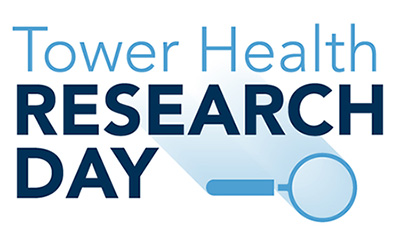Keywords:
Macrophage activation syndrome, SLE, hemophagocytic lymphohistiocytosis, immune activation
Start Date
14-10-2021 9:40 AM
End Date
14-10-2021 10:40 AM
Recommended Citation
oke, ibiyemi, "A Case of Macrophage Activation syndrome Heralding The Diagnosis of SLE" (2021). Tower Health Research Day. 5.
https://scholarcommons.towerhealth.org/th_researchday/2021/postersession1/5
A Case of Macrophage Activation syndrome Heralding The Diagnosis of SLE
Background
Macrophage activation syndrome (MAS) is a form of hemophagocytic lymphohistiocytosis that occurs primarily in patients with juvenile idiopathic arthritis or other Rheumatologic diseases but rarely in SLE. It is characterized by an aggressive and life-threatening syndrome of excessive immune activation and presents as an acute or subacute febrile illness associated with multiple organ involvement and often diagnosed late due to its rarity. We present a case of MAS precipitated by Ehrlichia infection leading to the diagnosis of SLE in a young male.
Case Presentation
A 26-year-old male with a history of chronic ITP and nephrolithiasis who presented to the ER with complaints of fever, fatigue, generalized weakness, and presyncope. He reported unintentional weight loss of 30 pounds in three months and two months history of fatigue, malaise, night sweats, polyarthralgia, and episodic swelling in fingers and toes. He has a family history of SLE in his mother and maternal aunt.
His vital signs in the ER: Temperature 38.7oc, HR 111/min, BP 122/75mmhg and RR 20cpm, SPO2 98% on RA. He had tenderness in the small joints of the hands and bilateral axillary and inguinal lymphadenopathy on physical examination.
His initial laboratory work-up revealed pancytopenia, transaminitis, low fibrinogen, elevated D-dimer, troponin, and lipase. He had wall motion abnormality, low ejection fraction, and pericardial effusion on Transthoracic Echocardiogram. CT Chest/Abdomen/Pelvis showed hepatomegaly, inguinal and axillary lymphadenopathy, and findings suggestive of acute pancreatitis. The top differential diagnoses were autoimmune disease and malignancy. Immunologic work-up revealed positive Anti-nuclear antibody, anti-double-stranded DNA, anti-smith antibody, anticardiolipin, and B2-glycoprotein antibodies. He also had low complement levels, elevated ferritin, and ESR. An extensive infectious screen revealed a positive Erhilichia IgM antibody. Table 1. Flow cytometry and Axillary lymph node pathology were negative for malignancy. He met the diagnostic criteria for SLE (5 of 11 ACR criteria) and had an HScore of 228 points (96-98% probability of hemophagocytic syndrome). He was treated with high-dose steroid and hydroxychloroquine and completed ten days of doxycycline.
Conclusion
This case is a rare presentation of MAS in a young man with previously undiagnosed SLE. Prompt diagnosis and treatment are important to prevent an adverse outcome.
Table 1:
Laboratory tests(units)
Result
Normal Range
White cell count (X 103/uL)
2.38
4.8 - 10.8
Platelet (X 103/uL)
53
130 - 400
Hemoglobin(g/dL)
10
14.0 - 17.5
ESR (mm/hr)
40
0-15
CRP (mg/dl)
0.4
<1.00
Fibrinogen(mg/dL)
218
193 - 488
Blood protein electrophoresis
Polyclonal Hypergammaglobulinemia; increased alpha 1 globulin and hypoalbuminemia
Ferritin(ng/mL)
7500
24 - 336
Triglyceride(mg/dL)
408
<175
Creatinine(mg/dL)
0.64
0.60 - 1.30
Troponin(ng/mL)
0.1
<=0.06
D-dimer(ug/ml)
5
<0.50
LDH (units/L)
289
140- 280
Lipase (IU/L)
306
11 - 82
Haptoglobin(mg/dL)
213
20-200
Procalcitonin(ng/mL)
1.07
<0.50
Anti-double stranded DNA antibody
1:40
1:10
Anti-Smith
>8
<1
Cardiolipin
1:38
<=14
ANA
1:640(homogenous pattern)
<40
DRVVT (Dilute Russell's viper venom time)
Positive
Negative
DRVVT (Dilute Russell's viper venom time)
175
<=45
Cardiolipin Ab IgG
38
<=14
Cardiolipin Ab IgA
<11
<=11
Cardiolipin Ab IgM
32
<=12
Beta 2 glycoprotein 1 IgG(SGU)
23
<=20
Beta 2 glycoprotein 1 IgA(SAU)
45
<=20
Beta 2 glycoprotein 1 IgM (SMU)
60
<=20
PhosSerine IGG
46
<10
C3(mg/dL)
29
90-180
C4(mg/dL)
6
15-45
Mitochondrial antibodies
Negative
Negative
Smooth Muscle antibody
Negative
Negative
ANCA Screening
Negative
Negative
Anti-liver/kidney microsomal antibodies (Anti-LKM-1)
Negative
Negative
Ehrlichia chaffeensis IgM Ab
1:40
<1:20
Ehrlichia chaffeensis IgG Ab
<1:64
<1:64


